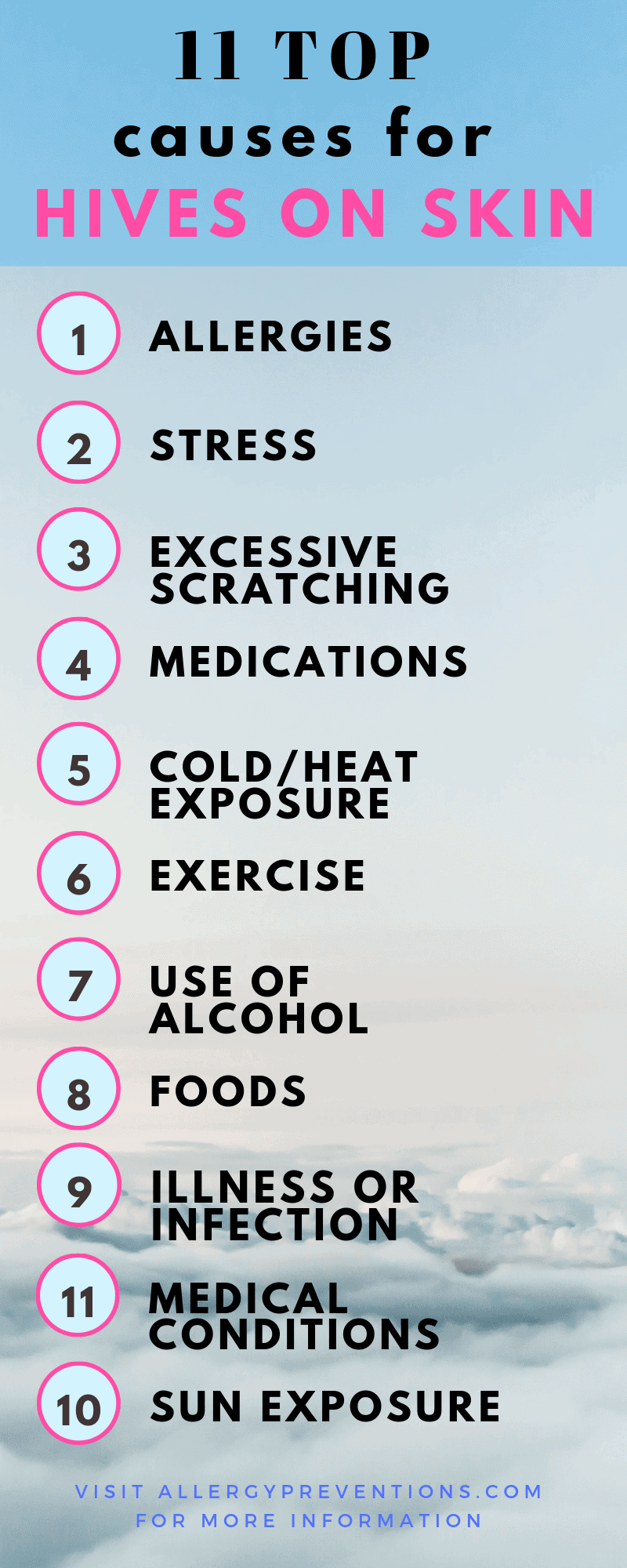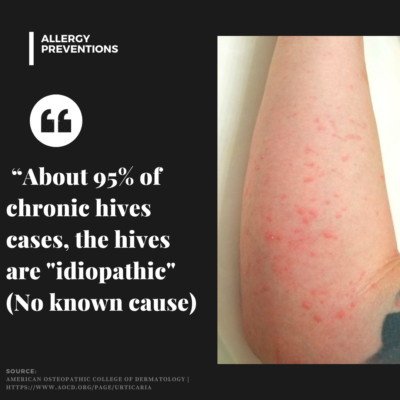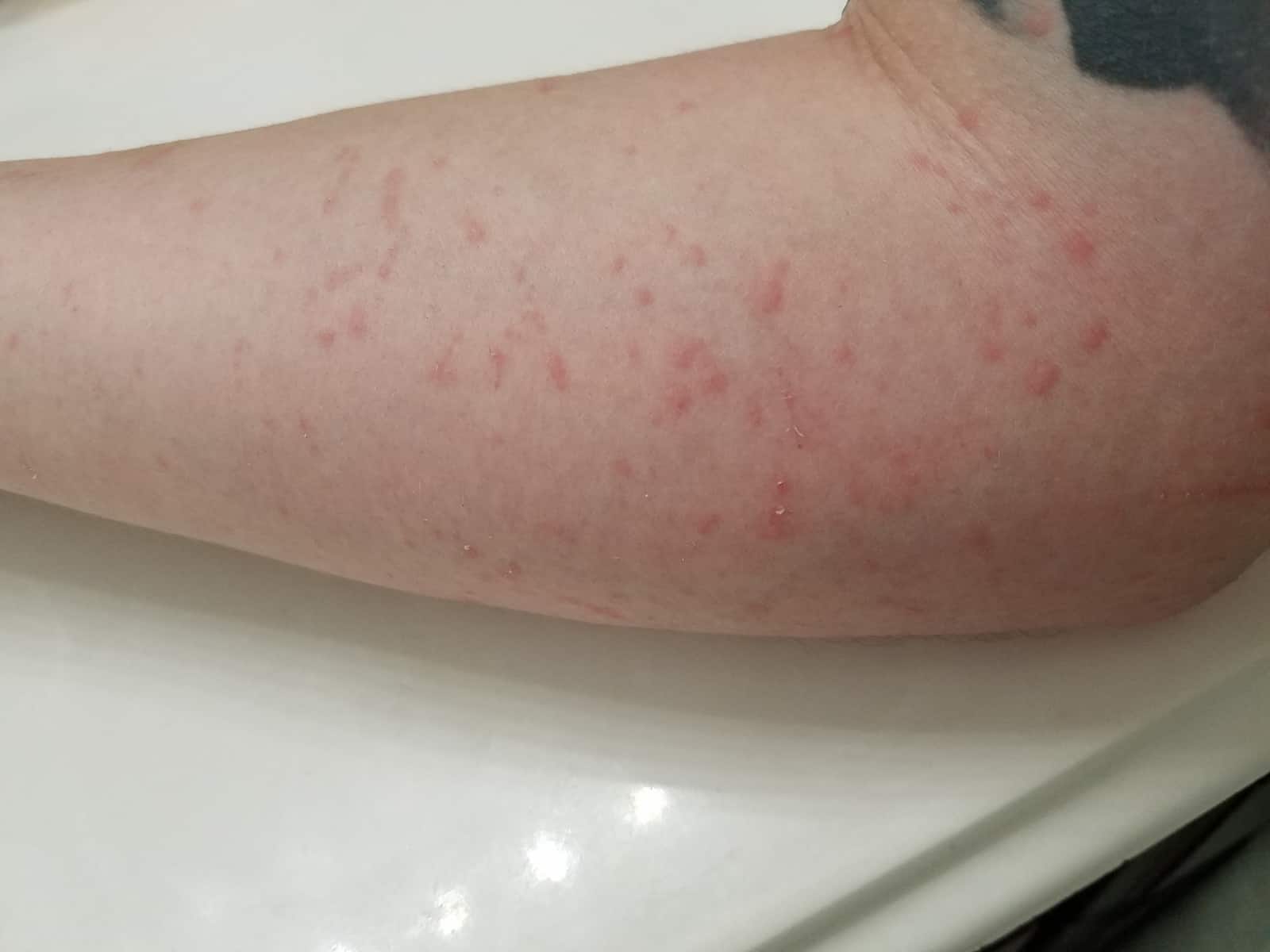Prepare yourself for the top causes for hives on skin. Hives are showing up and you don’t know why, and this may be your first time having them or it’s something you have been dealing with for some time. I have researched for countless hours to find the answers to all things hives. We will cover causes, symptoms, treatment/management options, and what I have used firsthand to treat hives with excellent results.

This post contains affiliate links. “As an Amazon Associate, I earn from qualifying purchases.”
What are Hives?
Merriam-Webster defines hives as “An allergic disorder marked by raised edematous patches of skin or mucous membrane and usually intense itching and caused by contact with a specific precipitating factor (such as a food, drug, or inhalant) either externally or internally.”
My definition of hives… “Itchy bumps”.

Hives take on so many different shapes and intensities, so it is difficult to explain how they look. I recommend looking at as many pictures of hives as you can to get the best understanding of how they look.
Other Common Names for Hives
Hives are also called urticaria (pronounced ur·ti·car·a) which is commonly mixed in with other terms like plaques, wheals, welts, or bumps. For this article, I am going to try and stick with the term hive(s).
Symptoms of Hives
I have had allergy-related symptoms of hives on my arms, legs, and trunk. These hives consisted of raised pink swollen areas, which were extremely itchy! My hive investigation has come up with this top list of symptoms for hives on the skin:
- Itchy and/or swollen welts
- Depending on the reaction can be small or large in size
- Can be red or skin-colored
- Painful swelling around sensitive areas of the face like the eyes, ears, nose, and mouth
- Symptoms can appear suddenly
- Burning sensation
Causes of Hives on Skin
The most common cause of hives is the trigger of an allergic reaction.
If you have a known allergy to things like pet dander, pollen, or medications, your allergic response may show in the form of hives on your skin.
Hives can be caused by a broad range of other situations and exposures besides allergies.
List of 11 Common Causes For Hives On The Skin

Allergies
The most common cause of hives is going to be from seasonal allergies. Hives are a systemic immune system response that lets your body know that something is up. Allergies are the immune system sounding the alarm for intruders, which happen to be allergens. The most common seasonal allergens are pollen from trees, grasses, and weeds, as well as mold, dust mites, and pet dander.
Hives from Medications
Johns Hopkins Medicine explains that hives from medications fall into three categories.
Reasons for a rash or hives from medication
- Allergic reaction to the medication (medication allergy)
- Medication side-effect
- Sun rash from increased sensitivity, caused by the medication
Sun Exposure
Solar Urticaria is a condition where sunlight causes you to develop hives when exposed. This is a rare condition but can cause hives nonetheless. Check out The Complete Guide to Sun Allergies for more information.
Excess Scratching
Scratching your skin excessively can cause hive-like reactions. These reactions can be a sign of a condition called dermatographia. If you have itchy skin, avoid scratching. Scratching will just make matters worse.
Exposure to Intense Heat or Cold
Extreme temperatures can cause hives. We have heard of the term “heat rash” well there is also a “cold rash”. These conditions are rare but can cause hives. If you are experiencing any rashes from extreme temperatures seek medical help.
Stress Hives
Have you found yourself more stressed than usual? You may be experiencing stress hives!
stress.org explains, “Stress hives can look a little like bug bites: both are red, puffy, and itchy, and may appear initially as individual bumps” – Mary Stevenson, Assistant Professor of Dermatology at NYU Langone
Exercise
There are medical conditions that cause you to develop hives when working out. These exercise-induced hives are sometimes related to food allergies, but not always. If you think you are developing hives from exercise, please speak with your doctor.
Use of Alcohol
The consumption of alcohol can produce hives and is not usually an allergic reaction to the alcohol itself. Allergy.org.au explains that you may be allergic to the ingredients (i.e. wheat, barley), feel flush from the alcohol, or you may have an enzyme deficiency.
Food Allergies
Food allergies can definitely be the cause of hives. Most food allergies are usually caused by one of the “Big 8” allergens.
Big 8 Allergens

- Milk
- Tree nuts
- Eggs
- Peanuts
- Fish
- Wheat
- Shellfish
- Soy
Illness or Infection
Sometimes hives are caused by an illness or infection. These can be chronic (long-lasting) or acute conditions. If an illness or infection is a possibility for your hives, your doctor may conduct a blood test to confirm.
Autoimmune Diseases or Unknown Causes

Certain autoimmune diseases are known to cause hives or urticaria. More often, the cause of hives is simply not known.
AOCD.org tells us, “About 95% of chronic hives cases, the hives are “idiopathic” (a medical term that means there is no discernible cause)
The duration of Hives Varies
The American Academy of Dermatology (AAD), informs us that hives typically go away in 24 hours or less, but as the original hives disappear new ones may appear. The appearance and disappearance of hives can last about 6 weeks. Hives that last more than 6 weeks are considered chronic hives.
You Are At Risk For Hives; Hives Are Not Biased
Who can get hives? Anyone! As we have learned, there are so many causes for hives that anyone could be affected at some point in their life. remember, 95% of all chronic hive cases do not have a known cause.
Location of Hives on Your Skin (and Beyond)
Here is a fun fact! You can get hives just about anywhere on your body including inside your mouth. The most common areas to experience hives are your arms, legs, and trunk/abdomen.
Hives Can Be Erratic, Irregular, and Inconsistent
The American College of Allergy, Asthma, and Immunology (ACAAI) states that hives can change shape, move around, disappear, and reappear over short periods of time.
In short, yes they can move around.
Hives Treatment and Management Options
- Hives can go away on their own without the need for treatments
- Clean the area with soap and water
- Avoid triggers that you know result in hives
- Use a cold compress on the hives to keep the skin cool and reduce inflammation
- Oatmeal Bath
- Taking antihistamines
I currently take Zyrtec, and I have been using this antihistamine for many years. I have found this to be the most beneficial antihistamine against my allergy symptoms.
If I need something a little more powerful I use Benadryl.
I get fast results and only need to take half a dose, if I take the full dose I tend to get sleepy. Benadryl comes in liquid, chewable, and tablet forms. Find what works for you.
Here is the exact product I use, there are also generic versions available as well.
Topical creams can aid in managing hives, like Benadryl anti-itch gel. My allergist uses this after my allergy shots every week and I have experienced immediate itch relief.
I tend to get hives after working outdoors, so I have some of this gel on hand at all times.
My Hives On My Arm After Mowing The Lawn
Here is a picture of my arm after mowing the lawn, this is the exact type of situation where I use the gel cream!

Luckily the cream is inexpensive and of course, it is found on Amazon. This gel is also useful for stings, burns, anti-itch, insect bites, poison ivy, and sunburn.
You really can’t go wrong with having this on hand.
The Best Treatments That Have Worked For Me
The treatment options that I have had the best results with are:
- Cleaning the area to remove triggers
- Avoiding triggers (easier said than done)
- Use a topical cream or Antihistamine pills
Sometimes these home care treatments don’t do the trick, or your symptoms evolve or get worse. You can never be too cautious when it comes to your health, always consult with a medical professional.
How can you be sure you have hives?
A trip to a dermatologist will be the best way to make the diagnosis of hives. Usually, you will have to see your primary physician and get a referral to a dermatologist. Keep in mind that your physician may initially treat at his or her level of care before referring to the specialist.
After diagnosis comes the tricky part for the medical professionals, finding why you have the hives. My hives were always allergy-related so I wasn’t referred to the dermatologist. Due to my severe environmental allergies, I was referred to an allergist for further evaluation instead.
Next, check out these pictures of hives and better understand what urticaria (hives) look like.
